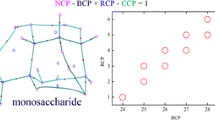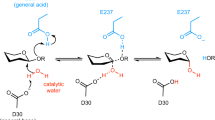Abstract
Xylobiose (β-d-xylopyranosyl-(1 → 4)-d-xylopyranose) could be regarded as the shortest and simplest xylan, a member of the hemicellulose family of molecules that interact with cellulose and lignin in plants. Those interactions, important in plant growth as well as in utilization of wood and cereal grains, depend partly on the molecular shapes. In this work, xylan conformations were modeled with xylobiose using the same density functional theory (DFT) quantum mechanics approach used previously for cellobiose, with both vacuum and solvated models. The region of lowest energy for the solvated model (but not for the vacuum model) accommodates the experimentally observed left-handed, threefold helical shape of xylan hydrate as well as most di- and oligosaccharide structures from the Cambridge Structural Database and the Protein Data Bank. We compared the energy surfaces of xylobiose and cellobiose to learn the effect of the CH2OH group of cellobiose. That comparison, and a similar comparison of non-hydroxyl bearing analogs, showed that the C6 group increased the relative energies of structures having ψC5 values between − 100° and + 40°. The energy map for the solvated, non-hydroxyl bearing xylobiose analog was surprisingly predictive of the observed experimental crystal structures. Comparisons with xylobiose maps from the literature are also presented. Although hydrogen bonding is frequently invoked to explain changes in carbohydrate structure and properties, condensed-phase experimental structures were predicted better by modeling methods with diminished strengths of hydrogen bonds. That suggests they are relatively unimportant in influencing the structure of β-(1 → 4)-linked molecules, in agreement with other work in the literature.












Similar content being viewed by others
Change history
28 July 2020
During the preparation of a follow-on manuscript, it was discovered that values of the temperatures of the distribution were miscalculated.
Notes
That non-reducing structure is 4-deoxy, 4-methyl, α-l-lyxose in the 1C4 ring conformation, a structure that lacks the possibilities for hydrogen bonding that β-D-xylose can achieve.
An important assumption was that the pyranosyl rings will retain the normal 4C1 (chair) conformation with equatorial hydroxyl groups, at least when they are in the low-energy regions of ϕ/ψ space. A recent study found a complex of xylobiose with oligoamide molecules (foldamers) in which the xylobiose took a 1C4 shape, explained by participation in a total of 18 hydrogen bonds (Saha et al. 2018). Although this is an interesting structure, we did not include such forms in our study as starting models.
References
Bader RFW (1990) Atoms in molecules: a quantum theory. Clarendon Press, Oxford
Berglund J, Angles D’ortoli T, Vilaplana F et al (2016) A molecular dynamics study of the effect of glycosidic linkage type in the hemicellulose backbone on the molecular chain flexibility. Plant J 88:56–70. https://doi.org/10.1111/tpj.13259
Berman HM, Battistuz T, Bhat TN et al (2002) The protein data bank. Acta Crystallogr Sect D Biol Crystallogr 58:899–907
Bürgi HB, Dunitz JD, IUCr (1988) Can statistical analysis of structural parameters from different crystal environments lead to quantitative energy relationships? Acta Crystallogr Sect B Struct Sci 44:445–448. https://doi.org/10.1107/S010876818800374X
Busse-Wicher M, Gomes TCF, Tryfona T et al (2014) The pattern of xylan acetylation suggests xylan may interact with cellulose microfibrils as a twofold helical screw in the secondary plant cell wall of Arabidopsis thaliana. Plant J 79:492–506. https://doi.org/10.1111/tpj.12575
Bye E, Schweizer WB, Dunitz JD (1982) Chemical reaction paths. 8. Stereoisomerization path for triphenylphosphine oxide and related molecules: indirect observation of the structure of the transition state. J Am Chem Soc 104:5893–5898. https://doi.org/10.1021/ja00386a008
Cantor CR (1997) IUPAC-IUBMB joint commission on biochemical nomenclature (JCBN) and nomenclature committee of IUBMB (NC-IUBMB). Eur J Biochem 247:733–739
Cocinero EJ, Gamblin DP, Davis BG, Simons JP (2009) The building blocks of cellulose: the intrinsic conformational structures of cellobiose, its epimer, lactose, and their singly hydrated complexes. J Am Chem Soc 131:11117–11123. https://doi.org/10.1021/ja903322w
Cosgrove DJ (2005) Growth of the plant cell wall. Nat Rev Mol Cell Biol 6:850–861. https://doi.org/10.1038/nrm1746
Ejby M, Fredslund F, Vujicic-Zagar A et al (2013) Structural basis for arabinoxylo-oligosaccharide capture by the probiotic Bifidobacterium animalis subsp. lactis Bl-04. Mol Microbiol 90:1100–1112. https://doi.org/10.1111/mmi.12419
French AD (2011) In defense of adiabatic φ/ψ mapping for cellobiose and other disaccharides. Cellulose 18:889–896. https://doi.org/10.1007/s10570-011-9538-7
French AD (2012) Combining computational chemistry and crystallography for a better understanding of the structure of cellulose. Adv Carbohydr Chem Biochem 67:19–93. https://doi.org/10.1016/B978-0-12-396527-1.00002-4
French AD (2014) Computerized models of carbohydrates. In: Ramawat K, Mérillon JM (eds) Polysaccharides: bioactivity and biotechnology. Springer, Cham, pp 1397–1440. https://doi.org/10.1007/978-3-319-03751-6_33-1
French AD, Csonka GI (2011) Hydroxyl orientations in cellobiose and other polyhydroxyl compounds: modeling versus experiment. Cellulose 18:897–909. https://doi.org/10.1007/s10570-011-9539-6
French AD, Johnson GP (2004) Advanced conformational energy surfaces for cellobiose. Cellulose 11:449–462. https://doi.org/10.1023/b:cell.0000046409.37326.b1
French AD, Johnson GP (2006) Quantum mechanics studies of cellobiose conformations. Can J Chem 84:603–612. https://doi.org/10.1139/V06-050
French AD, Johnson GP (2009) Cellulose and the twofold screw axis: modeling and experimental arguments. Cellulose 16:959–973. https://doi.org/10.1007/s10570-009-9347-4
French AD, Johnson GP (2011) Computerized molecular modeling of carbohydrates. Methods Mol Biol 715:21–42. https://doi.org/10.1007/978-1-61779-008-9_2
French AD, Kelterer AM, Cramer CJ et al (2000a) A QM/MM analysis of the conformations of crystalline sucrose moieties. Carbohydr Res 326:305–322. https://doi.org/10.1016/S0008-6215(00)00051-3
French AD, Kelterer AM, Johnson GP et al (2000b) Constructing and evaluating energy surfaces of crystalline disaccharides. J Mol Graph Model 18:95–107. https://doi.org/10.1016/S1093-3263(00)00041-3
French AD, Kelterer AM, Johnson GP et al (2001) HF/6-31G* energy surfaces for disaccharide analogs. J Comput Chem 22:65–78. https://doi.org/10.1002/1096-987X(20010115)22:1%3c65:AID-JCC7%3e3.0.CO;2-R
French AD, Johnson GP, Cramer CJ, Csonka GI (2012) Conformational analysis of cellobiose by electronic structure theories. Carbohydr Res 350:68–76. https://doi.org/10.1016/j.carres.2011.12.023
Frisch MJ, Trucks GW, Schlegel HB, Scuseria GE, Robb MA, Cheeseman JR, Scalmani G, Barone V, Petersson GA, Nakatsuji H, Li X, Caricato M, Marenich AV, Bloino J, Janesko BG, Gomperts R, Mennucci B, Hratchian HP, Ortiz JV, Izmaylov AF, Sonnenberg JL, Willia FD (2016) Gaussian 16
Gabbay SM, Sundararajan PR, Marchessault RH (1972) X-ray and stereochemical studies on xylan diacetate. Biopolymers 11:79–94. https://doi.org/10.1002/bip.1972.360110106
Gross L, Mohn F, Moll N et al (2012) Bond-order discrimination by atomic force microscopy. Science 337:1326–1329. https://doi.org/10.1126/SCIENCE.1225621
Guo Q, Kang J, Wu Y et al (2015) A molecular modeling approach to understand the structure and conformation relationship of (GlcpA)Xylan. Carbohydr Polym 134:175–181. https://doi.org/10.1016/J.CARBPOL.2015.06.036
Ha SN, Madsen LJ, Brady JW (1988) Conformational analysis and molecular dynamics simulations of maltose. Biopolymers 27:1927–1952. https://doi.org/10.1002/bip.360271207
Hatcher E, Säwén E, Widmalm G, MacKerell AD (2011) Conformational properties of methyl β-maltoside and methyl α- and β-cellobioside disaccharides. J Phys Chem B 115:597–608. https://doi.org/10.1021/jp109475p
Homans SW (1990) A molecular mechanical force field for the conformational analysis of oligosaccharides: comparison of theoretical and crystal structures of Man.alpha.1-3Man.beta.1-4GlcNAc. Biochemistry 29:9110–9118. https://doi.org/10.1021/bi00491a003
IUPAC Comm. on the Nomenclature of IC on the N of O, IUPAC-IUB Comm. on Biochem. Nomencl I-IC on B (1971) IUPAC commission on the nomenclature of organic chemistry (CNOC) and IUPAC-IUB commission on biochemical nomenclature (CBN) tentative rules for carbohydrate nomenclature. Biochemistry 10:3983–4004. https://doi.org/10.1021/bi00797a028
Johnson GP, Petersen L, French AD, Reilly PJ (2009) Twisting of glycosidic bonds by hydrolases. Carbohydr Res 344:2157–2166. https://doi.org/10.1016/j.carres.2009.08.011
Koritsanszky TS, Coppens P (2001) Chemical applications of X-ray charge-density analysis. Chem Rev Rev 101:1583–1628. https://doi.org/10.1021/CR990112C
Leth ML, Ejby M, Workman C et al (2018) Differential bacterial capture and transport preferences facilitate co-growth on dietary xylan in the human gut. Nat Microbiol 3:570–580. https://doi.org/10.1038/s41564-018-0132-8
Leung F, Marchessault RH (1973) Crystal structure of β-D, 1 → 4 xylobiose hexaacetate. Can J Chem 51:1215–1222
Lii J-H, Chen K-H, Johnson GP et al (2005) The external-anomeric torsional effect. Carbohydr Res 340:853–862. https://doi.org/10.1016/j.carres.2005.01.032
Marenich AV, Cramer CJ, Truhlar DG (2009) Universal solvation model based on solute electron density and on a continuum model of the solvent defined by the bulk dielectric constant and atomic surface tensions. J Phys Chem B 113:6378–6396
Martínez-Abad A, Berglund J, Toriz G et al (2017) Regular motifs in xylan modulate molecular flexibility and interactions with cellulose surfaces. Plant Physiol 175:1579–1592. https://doi.org/10.1104/pp.17.01184
Mazeau K, Moine C, Krausz P, Gloaguen V (2005) Conformational analysis of xylan chains. Carbohydr Res 340:2752–2760. https://doi.org/10.1016/j.carres.2005.09.023
Moran RA, Richards GF (1973) The crystal and molecular structure of an aldotriouronic acid trihydrate: O-(4-O-methyl-α-d-glucopyranosyluronic acid)-(1-2)-O-β-d-xylopyranosyl-(1-4)-d-xylopyranose trihydrate. Acta Crystallogr Sect B Struct Crystallogr Cryst Chem 29:2770–2783
Nieduszynski IA, Marchessault RH (1972) Structure of β, D (1– > 4′)-xylan hydrate. Biopolymers 11:1335–1344
Nimlos MR, Qian X, Davis M et al (2006) Energetics of xylose decomposition as determined using quantum mechanics modeling. J Phys Chem A 110:11824–11838. https://doi.org/10.1021/jp0626770
Ordaz-Ortiz J, Guillon F, Tranquet O et al (2004) Specificity of monoclonal antibodies generated against arabinoxylans of cereal grains. Carbohydr Polym 57:425–433. https://doi.org/10.1016/j.carbpol.2004.05.016
Payal RS, Bharath R, Periyasamy G, Balasubramanian S (2012) Density functional theory investigations on the structure and dissolution mechanisms for cellobiose and xylan in an ionic liquid: gas phase and cluster calculations. J Phys Chem B 116:833–840. https://doi.org/10.1021/jp207989w
Peralta-Inga Z, Johnson GP, Dowd MK et al (2002) The crystal structure of the α-cellobiose·2 NaI·2H2O complex in the context of related structures and conformational analysis. Carbohydr Res 337:851–861. https://doi.org/10.1016/S0008-6215(02)00041-1
Ramachandran GN, Ramakrishnan C, Sasisekharan V (1963) Stereochemistry of polypeptide and polysaccharide chain conformations. In: Ramachandran GN (ed) Aspects of protein structure. Academic Press, Cambridge, pp 121–135
Rees DA, Skerrett RJ (1968) Conformational analysis of cellobiose, cellulose, and xylan. Carbohydr Res 7:334–348. https://doi.org/10.1016/S0008-6215(00)81206-9
Saha BC (2003) Hemicellulose bioconversion. J Ind Microbiol Biotechnol 30:279–291
Santiago Cintrón M, Johnson GP, French AD (2017) Quantum mechanics models of the methanol dimer: O[sbnd]H···O hydrogen bonds of β-d-glucose moieties from crystallographic data. Carbohydr Res 443–444:87–94. https://doi.org/10.1016/j.carres.2017.03.007
Schnupf U, Momany FA (2011) Rapidly calculated DFT relaxed iso-potential ϕ/ψ maps: β-cellobiose. Cellulose 18:859–887. https://doi.org/10.1007/s10570-011-9537-8
Strati GL, Willett JL, Momany FA (2002) Ab initio computational study of beta-cellobiose conformers using B3LYP/6-311 ++G**. Carbohydr Res 337:1833–1849. https://doi.org/10.1016/s0008-6215(02)00267-7
Sundararajan PR, Rao VSR (1969) Conformational studies of β-D-1, 4′-xylan. Biopolymers 8:305–312
Wang D, Ámundadóttir ML, van Gunsteren WF, Hünenberger PH (2013) Intramolecular hydrogen-bonding in aqueous carbohydrates as a cause or consequence of conformational preferences: a molecular dynamics study of cellobiose stereoisomers. Eur Biophys J 42:521–537. https://doi.org/10.1007/s00249-013-0901-5
Wang T, Yang H, Kubicki JD, Hong M (2016) Cellulose structural polymorphism in plant primary cell walls investigated by high-field 2D solid-state NMR spectroscopy and density functional theory calculations. Biomacromol 17:2210–2222. https://doi.org/10.1021/acs.biomac.6b00441
Yoneda Y, Mereiter K, Jaeger C et al (2008) Van der Waals versus hydrogen-bonding forces in a crystalline analog of cellotetraose: cyclohexyl 4′-O-cyclohexyl β-d-cellobioside cyclohexane solvate. J Am Chem Soc 130:16678–16690. https://doi.org/10.1021/ja805147t
Zhang J, Chen P, Yuan B et al (2013) Real-space identification of intermolecular bonding with atomic force microscopy. Science 342:611–614. https://doi.org/10.1126/science.1242603
Acknowledgments
Results from Martínez-Abad et al. (2017) were graciously provided by Jakob Wohlert and Jennie Berglund. Jakob Wohlert and Michael Santiago Cintrón reviewed a pre-submission version of the manuscript. The authors gratefully acknowledge financial support by the Chinese Scholarship Council (CSC No. 201706510045). We also deeply appreciate Dr. Ruben Tikidji-Hamburyan of Louisiana State University for technical assistance.
Author information
Authors and Affiliations
Corresponding authors
Additional information
Publisher's Note
Springer Nature remains neutral with regard to jurisdictional claims in published maps and institutional affiliations.
Electronic supplementary material
Below is the link to the electronic supplementary material.
Rights and permissions
About this article
Cite this article
Ling, Z., Edwards, J.V., Nam, S. et al. Conformational analysis of xylobiose by DFT quantum mechanics. Cellulose 27, 1207–1224 (2020). https://doi.org/10.1007/s10570-019-02874-3
Received:
Accepted:
Published:
Issue Date:
DOI: https://doi.org/10.1007/s10570-019-02874-3




